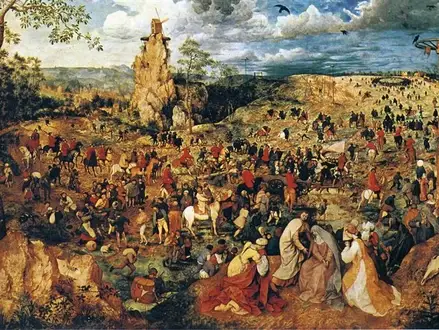Title of Artwork: “The Procession to Calvary”

Artwork by Pieter Bruegel the Elder
Year Created 1564
Summary of The Procession to Calvary
Painting by Pieter Bruegel the Elder, known as the Elder Pieter Bruegel, depicts Christ’s journey to Calvary in a large landscape. This piece is housed in Vienna’s Kunsthistorische Museum.
All About The Procession to Calvary
By comparison, this is the artist’s second-largest known painting. Niclaes Jonghelinck, the wealthy Antwerp collector, listed sixteen of his paintings in his inventory in 1566, including this one. Jonghelinck commissioned Bruegel’s Months, and he may have also commissioned this piece. The city of Antwerp purchased Jonghelinck’s Bruegels in the year of the inventory. Once in Prague, it was transferred to Vienna and then Paris, where Napoleon Bonaparte took it as a war prize until the end of the Napoleonic wars in 1809 (until he was forced to give it up in 1815).
Compositionally, this piece is out of character for Bruegel. Pieter Aertsen, Bruegel’s Antwerp contemporary, and the Brunswick Monogrammist both used a well-known scheme when depicting a solemn religious event. Mary and her companions are placed in an artificial foreground in order to distance them from what is going on behind them, which is a common technique in mannerist painting (see The Preaching of John the Baptist and The Conversion of Paul).
As he progressed through his career, Bruegel’s landscapes shifted from the expansive views of the Large landscape series to the remarkable naturalism of the Months. The landscape tradition of the Antwerp school, founded by Joachim Patinir, is characterised by rock outcrops like this one on the left. In particular, Herri met de Bles, Matthys Cock (the brother of Bruegel’s print publisher, Hieronymous Cock), and Cornelis Matsys had turned Patinir’s style into a popular, but stale formula. It is evident from the progression of Bruegel’s landscape drawings and paintings that he gradually abandoned this formula. However, in this instance, he is forced to rely on the pre-made landscape features of the Antwerp school in order to convey the Holy Land’s rocky, unfamiliar terrain.
His paintings are full of vividness that comes from his careful observation of modern life, as seen in this detail at the right. Public executions were common in the 16th century, particularly in Flanders, which was plagued by political turmoil. Bruegel depicts the procession of the two criminals who were to be crucified alongside Christ. Both of them have crucifixes in their hands and are making their final confessions to the hooded priests standing nearby. Modern-day attire is worn by the thieves, their confessors, and the macabre onlookers who encircle the cart. Executions in Bruegel’s time were well-attended events that had the feel of a carnival. Bruegel depicts the adoring crowd’s complete disregard for the plight of the condemned men in this painting. To show the crowds at such events were prey to pickpockets and vendors, the artist shows them elsewhere in the picture. However, Bruegel doesn’t differentiate between the two robbers Christ was to bless.
Information Citations
En.wikipedia.org, https://en.wikipedia.org/.





















